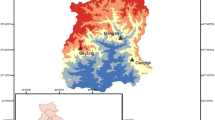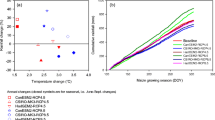Abstract
Climate change is affecting the productivity of crops and their regional distribution. Strategies to enhance local adaptation capacity are needed to mitigate climate change impacts and to maintain regional stability of food production. The objectives of this study were to simulate the climate change effects on phenological stages, Leaf Area Index (LAI), biomass and grain yield of maize (Zea mays L.) in the future and to explore the possibilities of employing irrigation water and planting dates as adaptation strategies to decrease the climate change impacts on maize production in Khorasan Razavi province, Iran. For this purpose, we employed two types of General Circulation Models ((United Kingdom Met. Office Hadley Center: HadCM3) and (Institute Pierre Simon Laplace: IPCM4)) and three scenarios (A1B, A2 and B1). Long Ashton Research Station-Weather Generator (LARS-WG) was used to produce daily climatic parameters as one stochastic growing season for each projection period. Also, crop growth under projected climate conditions was simulated based on the Cropping System Model (CSM)-CERES-Maize. The results of model evaluation showed that LARS-WG had appropriate prediction for climatic parameters. Time period from cultivation until anthesis and maturity were reduced in majority of scenarios as affected by climate change. The results indicated that the grain yield of maize may be reduced (11 % to 38 %) as affected by climate change based on common planting date in baseline and changed (−61 % to 48 %) in response to different irrigation regimes in the future climate change, under all scenarios and times. In general, earlier planting date (1 May) and decreasing irrigation intervals in the anthesis stage (11 applications) caused higher yield compared with other planting dates due to adaption to high temperature. Based on our findings, it seems that management of irrigation water and planting dates can be beneficial for adaptation of maize to climate change in this region.







Similar content being viewed by others
References
Abraha MG, Savage MJ (2006) Potential impacts of climate change on the grain yield of maize for the midlands of KwaZulu-Natal, South Africa. Agric Ecosyst Environ 115:150–160
Baker DG, Sharratt BS, Chiang HC et al (1984) Base temperature selection for the prediction of European corn borer instars by the growing degree day method. Agric For Meteorol 32:55–60
Bannayan M, Hoogenboom G (2008) Weather analogue: a tool for real-time prediction of daily weather data realizations based on a modified k-Nearest Neighbor approach. Environ Model Softw 3:703–713
Bindi M, Olesen J (2000) Agriculture. In: Parry ML (ed) Assessment of potential effect and adaptations for climate change in Europe: The Europe ACACIA Project, Jackson Environment Institute, University of East Anglia, Norwich, UK, 324 pp
Chartzoulakis K, Psarras G (2005) Global change effects on crop photosynthesis and production in Mediterranean: the case of Crete, Greece. Agric Ecosyst Environ 106:147–157
Conover WJ (1980) Practical nonparametric statistics, 2nd edn. Wiley, New York
Darwin R, Kennedy D (2000) Economic effects of CO2 fertilisation of crops: transferring changes in yield into changes in supply. Environ Model Assess 5:157–162
De Wit AJW, Boogaard HL, van Diepen CA (2005) Spatial resolution of precipitation and radiation: the effect on regional crop yield forecasts. Agric For Meteorol 135:156–168
Falloon P, Betts R (2010) Climate impacts on European agriculture and water management in the context of adaptation and mitigation-The importance of an integrated approach. Sci Total Environ 408:5667–5687
Giorgi F, Bi XQ (2005) Updated regional precipitation and temperature changes for the 21st century from ensamples of recent AOGCM simulations. Geophys Res Lett 32:L21715
Huang Y, Yu Y, Zhang W et al (2009) Agro-C: a biogeophysical model for simulating the carbon budget of agroecosystems. Agric For Meteorol 149:106–129
IPCC (Intergovernmental Panel on Climate Change) (2007) The physical science basis. Contribution of Working Group I to the Fourth Assessment Report of the Intergovernmental Panel on Climate Change. Cambridge, United Kingdom: Cambridge University Press p. 996. New York, NY, USA
Jones CA, Kiniry JR (1986) CERES-Maize: a simulation model for maize growth and development. Texas A&M University Press, College Station
Jones GP, Thornton PK (2003) The potential impacts of climate change on maize production in Africa andLatin America in 2055. Glob Environ Chang 13:51–59
Jones JW, Hoogenboom G, Porter CH et al (2003) The DSSAT cropping system model. Eur J Agron 18:235–265
Khabba S, Ledent JF, Lahrouni A (2001) Maize ear temperature. Eur J Agron 14:197–208
Khan MS, Coulibaly P, Dibike Y (2006) Uncertainty analysis of statistical downscaling methods. J Hydrol 319:357–382
Loague K, Green RE (1991) Statistical and graphical methods for evaluating solute transport models: overview and application. J Contam Hydrol 7:51–73
MAJ (Ministry of Agriculture of the I.R. of Iran) (2009) Planning and Economics Department, Statistics Bank of Iranian Agriculture, <http://www.maj.ir/english/Statistic/Default.asp?p=statistic>
Mall RK, Lal M, Bhatia VS et al (2004) Mitigating climate change impact on soybean productivity in India: a simulation study. Agric For Meteorol 121:113–125
Meza FJ, Silva D, Vigil H (2008) Climate change impacts on irrigated maize in Mediterranean climates: evaluation of double cropping as an emerging adaptation alternative. Agric Syst 98:21–30
Mitchell JFB, Johns TC, Gregory JM, Tett S (1995) Climate response to increasing levels of greenhouse gases as sulphate aerosols. Nature 376:501–504
Nash JE, Sutcliffe JV (1970) River flow forecasting through conceptual models. Part I: A discussion of principles. J Hydrol 10:282–290
Nassiri Mahallati M, Koocheki A (2005) Effects of climate change on agroclimatic indices in rainfed wheat production areas of Iran. Iran J Field Crop Res 3:303–314 (In Persian)
Nonhebel S (1996) Effects of temperature rise and increase in CO2 concentration on simulated wheat yields in Europe. Clim Change 34:73–90
Ogle SM, Breidt FJ, Paustian K (2005) Agricultural management impacts on soil organic carbon storage under moist and dry climatic conditions of temperate and tropical regions. Biogeochem 72:87–121
Olesen JE, Trnka M, Kersebaum KC et al (2011) Impacts and adaptation of European crop production systems to climate change. Eur J Agron 34:96–112
Ozkan B, Akcaoz H (2002) Impacts of climate factors on yields for selected crops in southern Turkey. Mitig Adapt Strateg Glob Change 7:367–380
Parry M, Fischer C, Livermore M et al (1999) Climate change and world food security: a new assessment. Glob Environ Change 9:851–867
Powlson DS, Christian DG, Falloon P, Smith P (2001) Biofuel crops: their potential contribution to decreased fossil carbon emissions and additional environmental benefits. Asp Appl Biol 65:289–294
Prudhomme C, Wilby RL, Crooks S et al (2010) Scenario-neutral approach to climate change impact studies: application to flood risk. J Hydrol 390:198–209
Quiring SM, Legates DR (2008) Application of CERES-Maize for within-season prediction of rainfed corn yields in Delaware, USA. Agric For Meteorol 148:964–975
Reidsma P, Ewert F, Lansink AO, Leemans R (2010) Adaptation to climate change and climate variability in European agriculture: the importance of farm level responses. Eur J Agron 32:91–102
Rosenzweig C, Tubiello FN (2007) Adaptation and mitigation strategies in agriculture: an analysis of potential synergies. Mitig Adapt Strateg Glob Change 12:855–873
Semenov MK, Brooks RJ (1999) Spatial interpolation of the LARS-WG stochastic weather generator in Great Britain. Clim Res 11:137–148
Semenov MK, Stratonovitch A (2010) Use of multi-model ensembles from global climate models for assessment of climate change impacts. Clim Res 41:1–14
Shiferaw BA, Okello J, Reddy RV (2009) Adoption and adaptation of natural resource management innovations in smallholder agriculture: reflections on key lessons and best practices. Environ Dev Sustain 11:601–619
Smit B, Skinner MW (2002) Adaptation options in agriculture to climate change: a typology. Mitig Adapt Strateg Glob Change 7:85–114
Soler CMT, Sentelhas PC, Hoogenboom G (2007) Application of the CSM-CERES-Maize model for planting date evaluation and yield forecasting for maize grown off-season in a subtropical environment. Europ J Agronomy 27:165-177
Trnka M, Dubrovsky M, Ekzalud Z (2004) Climate change impacts and adaptation strategies in spring barley production in the Czech Republic. Clim Change 64:227–255
Tubiello FN, Jagtap S, Rosenzweig C et al (2002) Effects of climate change on US crop production from the National Assessment. Simulation results using two different GCM scenarios. Part I: wheat, potato, corn, and citrus. Clim Res 20:259–270
Vergé XPC, De Kimpe C, Desjardins RL (2007) Agricultural production, greenhouse gas emissions and mitigation potential. Agric For Meteorol 2–4:255–269
Wang M, Li Y, Ye W et al (2011) Effects of climate change on maize production, and potential adaptation measures: a case study in Jilin Province, China. Clim Res 46:223–242
Wetterhall F, Bardossy A, Chen D, Halldin S, Ch XU (2009) Statistical downscaling of daily precipitation over Sweden using GCM output. Theor Appl Climatol 96:95–103
Winters P, Murgai R, Janvry A et al (1999) Climate change and agriculture: effects on developing countries. In: Frisvold G, Kuhn B (eds) Global environmental change and agriculture. Edward Elgar Publishers, Cheltenham
Xiong W, Matthews R, Holman I, Lin E, Xu Y (2007) Modelling China’s potential maize production at regional scale under climate change. Clim Change 85:433–451
Yang JC, Zhang JH (2006) Grain filling of cereals under soil drying. New Phytol 169:223–236
Yates DN, Strzepek KM (1998) An assessment of integrated climate change impacts on the agricultural economy of Egypt. Clim Change 38:261–287
Acknowledgments
The authors acknowledge the financial support of the project by Ferdowsi University of Mashhad, Iran.
Author information
Authors and Affiliations
Corresponding author
Rights and permissions
About this article
Cite this article
Moradi, R., Koocheki, A., Nassiri Mahallati, M. et al. Adaptation strategies for maize cultivation under climate change in Iran: irrigation and planting date management. Mitig Adapt Strateg Glob Change 18, 265–284 (2013). https://doi.org/10.1007/s11027-012-9410-6
Received:
Accepted:
Published:
Issue Date:
DOI: https://doi.org/10.1007/s11027-012-9410-6




